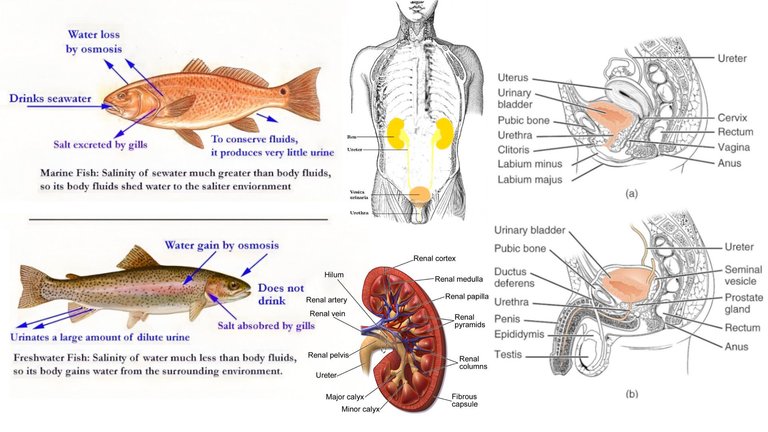In this video I discuss how animals regulate their body fluid composition. Vertebrate animals have kidneys which filter out blood plasma and expel the waste as urine through the urethra. Some animals such as the kangaroo rats minimize water loss by having highly concentrated urine, which allows them to adapt to desert environments.
In contrast, aquatic animals have diverse fluid compositions relative to their environment. Most invertebrate animals are isosmotic with seawater while saltwater fish are hyposmotic and freshwater fish are hyperosmotic. This means that seawater or marine fish have to constantly drink water since their bodies constantly lose water via osmosis. Freshwater fish are the opposite and have to constantly urinate because osmosis causes their bodies to constantly absorb water.

Time stamps
- Body fluids have 3 properties: osmotic pressure, ionic composition, and volume: 0:00
- Comparison between marine fish and freshwater fish: 3:55
- Vertebrate animals have kidneys which produce urine from blood plasma: 7:06
- Diagram of the female and male urethra to expel urine from the body: 10:33
- Diagrams of the ureters and kidneys: 12:45
- Diagram of nephrons inside kidneys: 15:28
- Nephron filters out flood to obtain urine: 17:45
Full video below
- Summary: SOON
- Full video and playlist: https://www.youtube.com/playlist?list=PLai3U8-WIK0FYO6bxFbBAtVJ9sDOJnH72
- Notes: https://peakd.com/hive-128780/@mes/messcience-3-overview-of-biology
- MES Science playlist: https://www.youtube.com/playlist?list=PLai3U8-WIK0GhjCHmTw1XbqMD_EdVKdd9 .
Become a MES Super Fan! https://www.youtube.com/channel/UCUUBq1GPBvvGNz7dpgO14Ow/join
DONATE! ʕ •ᴥ•ʔ https://mes.fm/donate
SUBSCRIBE via EMAIL: https://mes.fm/subscribe
MES Links: https://mes.fm/links
MES Truth: https://mes.fm/truth
Official Website: https://MES.fm
Hive: https://peakd.com/@mes
Email me: contact@mes.fm
Free Calculators: https://mes.fm/calculators
BMI Calculator: https://bmicalculator.mes.fm
Grade Calculator: https://gradecalculator.mes.fm
Mortgage Calculator: https://mortgagecalculator.mes.fm
Percentage Calculator: https://percentagecalculator.mes.fm
Free Online Tools: https://mes.fm/tools
iPhone and Android Apps: https://mes.fm/mobile-apps
▶️ 3Speak